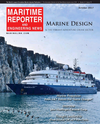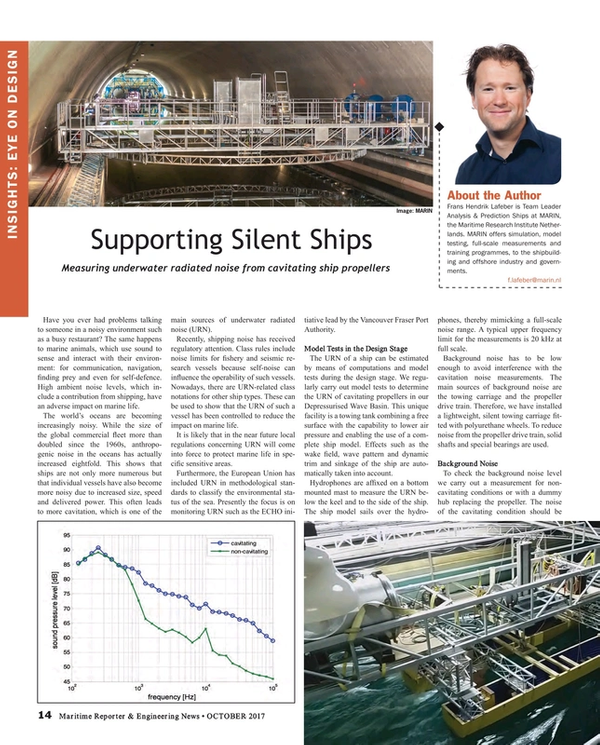
Supporting Silent Ships
By Frans Hendrik Lafeber
Measuring underwater radiated noise from cavitating ship propellers
Have you ever had problems talking to someone in a noisy environment such as a busy restaurant? The same happens to marine animals, which use sound to sense and interact with their environment: for communication, navigation, finding prey and even for self-defence. High ambient noise levels, which include a contribution from shipping, have an adverse impact on marine life.
The world’s oceans are becoming increasingly noisy. While the size of the global commercial fleet more than doubled since the 1960s, anthropogenic noise in the oceans has actually increased eightfold. This shows that ships are not only more numerous but that individual vessels have also become more noisy due to increased size, speed and delivered power. This often leads to more cavitation, which is one of the main sources of underwater radiated noise (URN).
Recently, shipping noise has received regulatory attention. Class rules include noise limits for fishery and seismic research vessels because self-noise can influence the operability of such vessels. Nowadays, there are URN-related class notations for other ship types. These can be used to show that the URN of such a vessel has been controlled to reduce the impact on marine life.
It is likely that in the near future local regulations concerning URN will come into force to protect marine life in specific sensitive areas.
Furthermore, the European Union has included URN in methodological standards to classify the environmental status of the sea. Presently the focus is on monitoring URN such as the ECHO initiative lead by the Vancouver Fraser Port Authority.
Model Tests in the Design Stage
The URN of a ship can be estimated by means of computations and model tests during the design stage. We regularly carry out model tests to determine the URN of cavitating propellers in our Depressurised Wave Basin. This unique facility is a towing tank combining a free surface with the capability to lower air pressure and enabling the use of a complete ship model. Effects such as the wake field, wave pattern and dynamic trim and sinkage of the ship are automatically taken into account.
Hydrophones are affixed on a bottom mounted mast to measure the URN below the keel and to the side of the ship. The ship model sails over the hydrophones, thereby mimicking a full-scale noise range. A typical upper frequency limit for the measurements is 20 kHz at full scale.
Background noise has to be low enough to avoid interference with the cavitation noise measurements. The main sources of background noise are the towing carriage and the propeller drive train. Therefore, we have installed a lightweight, silent towing carriage fitted with polyurethane wheels. To reduce noise from the propeller drive train, solid shafts and special bearings are used.
Background Noise
To check the background noise level we carry out a measurement for non-cavitating conditions or with a dummy hub replacing the propeller. The noise of the cavitating condition should be at least 3 dB, and preferably more than 10 dB, higher than the (non-cavitating) background noise. The figure shows background noise (green line) and cavitation noise (blue line) measured at model scale.
Test conditions are based on propulsion characteristics of the ship and the scale factor. In some cases a reduction of the cavitation number is applied to mitigate the viscous scale effects on the inception of vortex cavitation. We have recently tested this new method and achieved good results.
The measured data should be processed accounting for the influence of acoustic characteristics of the facility. Only the part of the measurement where the distance between the noise source and the receiver is smaller than the reverberation radius should be analyzed. Interference between direct noise and reflections of sound from the free surface influences the measured noise levels and should be corrected for. Noise levels are then normalized to a distance of one meter, while taking the time-dependent distance between the ship model and the hydrophones into account. Finally, we convert the results to full-scale values in one-third octave bands.
Validation Studies
Several validation studies have recently been carried out to determine the accuracy of the scaled-up results of the URN model tests. One such study was performed within the EU FP7 SONIC project (see MARIN Report 118). Another case is a single-screw merchant vessel for which an extensive full-scale data set is available from the CRS .
These validation studies show that model tests are a reliable way of checking the noise levels from propeller cavitation, which can be used to assess environmental impact. This helps to make shipping silent and to keep the oceans quiet.
Recent MARIN papers on URN model tests:
-Bosschers, J., Lafeber, F.H., de Boer, J., Bosman, R. and Bouvy, A. (2013). “Underwater Radiated Noise Measurements with a Silent Towing Carriage in the Depressurized Wave Basin”, AMT’13, Gdansk, Poland
-Lafeber, F.H., Bosschers, J., de Jong, C. and Graafland, F. (2015). “Acoustic Reverberation Measurements in the Depressurized Wave Basin”, AMT’15, Istanbul, Turkey
-Lafeber, F.H. and Bosschers, J. (2016). “Validation of computational and experimental prediction methods for the underwater radiated noise of a small research vessel”, PRADS2016, Copenhagen, Denmark
The Author
Frans Hendrik Lafeber is Team Leader Analysis & Prediction Ships at MARIN, the Maritime Research Institute Netherlands. MARIN offers simulation, model testing, full-scale measurements and training programmes, to the shipbuilding and offshore industry and governments.
(As published in the October 2017 edition of Maritime Reporter & Engineering News)
Read Supporting Silent Ships in Pdf, Flash or Html5 edition of October 2017 Maritime Reporter
Other stories from October 2017 issue
Content
- Supporting Silent Ships page: 14
- Cyber Shoal Waters page: 18
- US Shipbuilding: The Road Ahead page: 22
- Keller Shifts Gears page: 24
- MAN Introduces the 'Game Changer' page: 26
- Voices: Bjarne Foldager, MAN Diesel & Turbo page: 30
- Voices: John Haeflinger, Carnival Corp. page: 35
- Designer-built Adventure Cruise page: 40
- Robert Allan Ltd. Designs for the American Market page: 46
- Foreship: A Guiding Design Light amid a Quagmire of Regulations page: 50
- Hans Beele's Mission to Build Sealing Valley page: 58
- Ship of the Month: October 2017 page: 62


